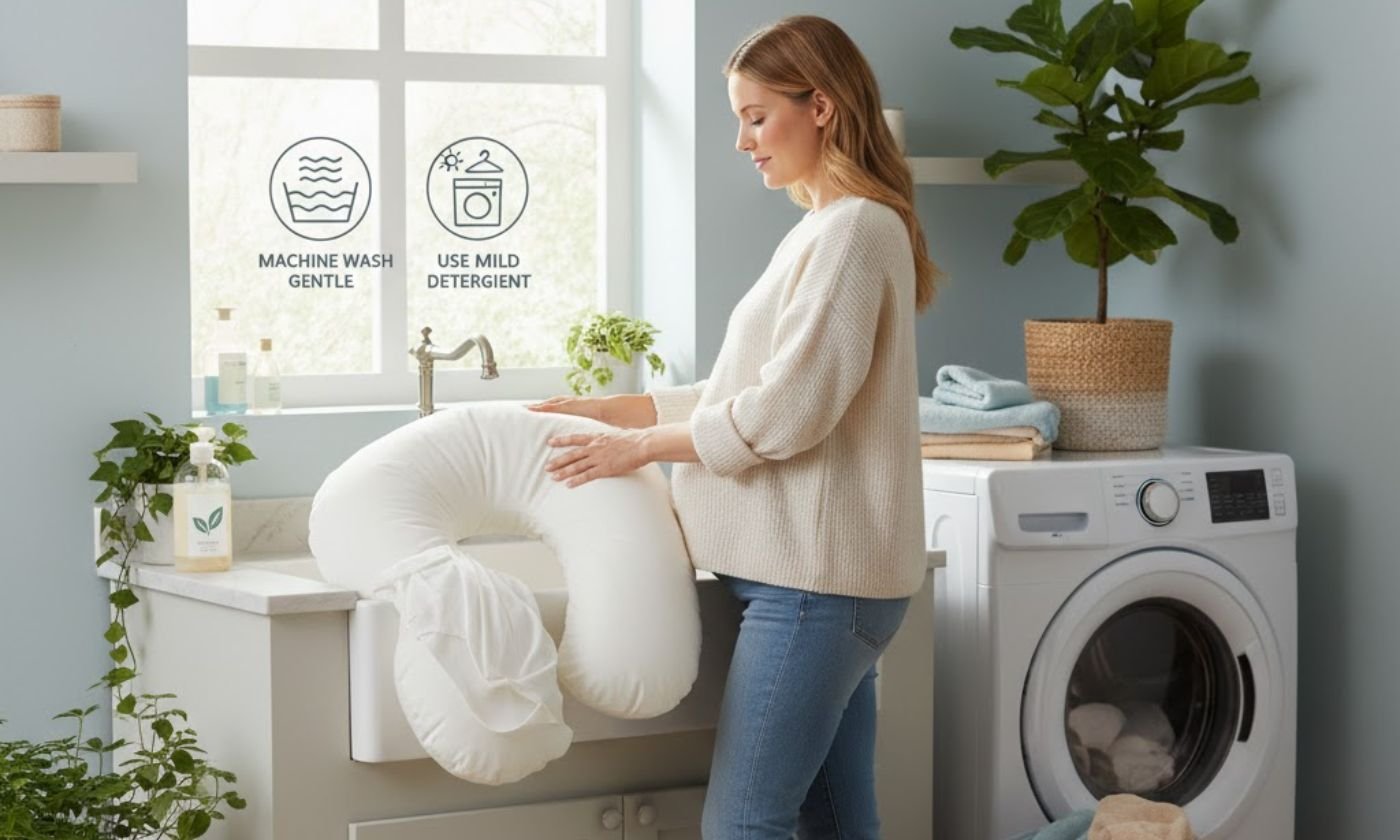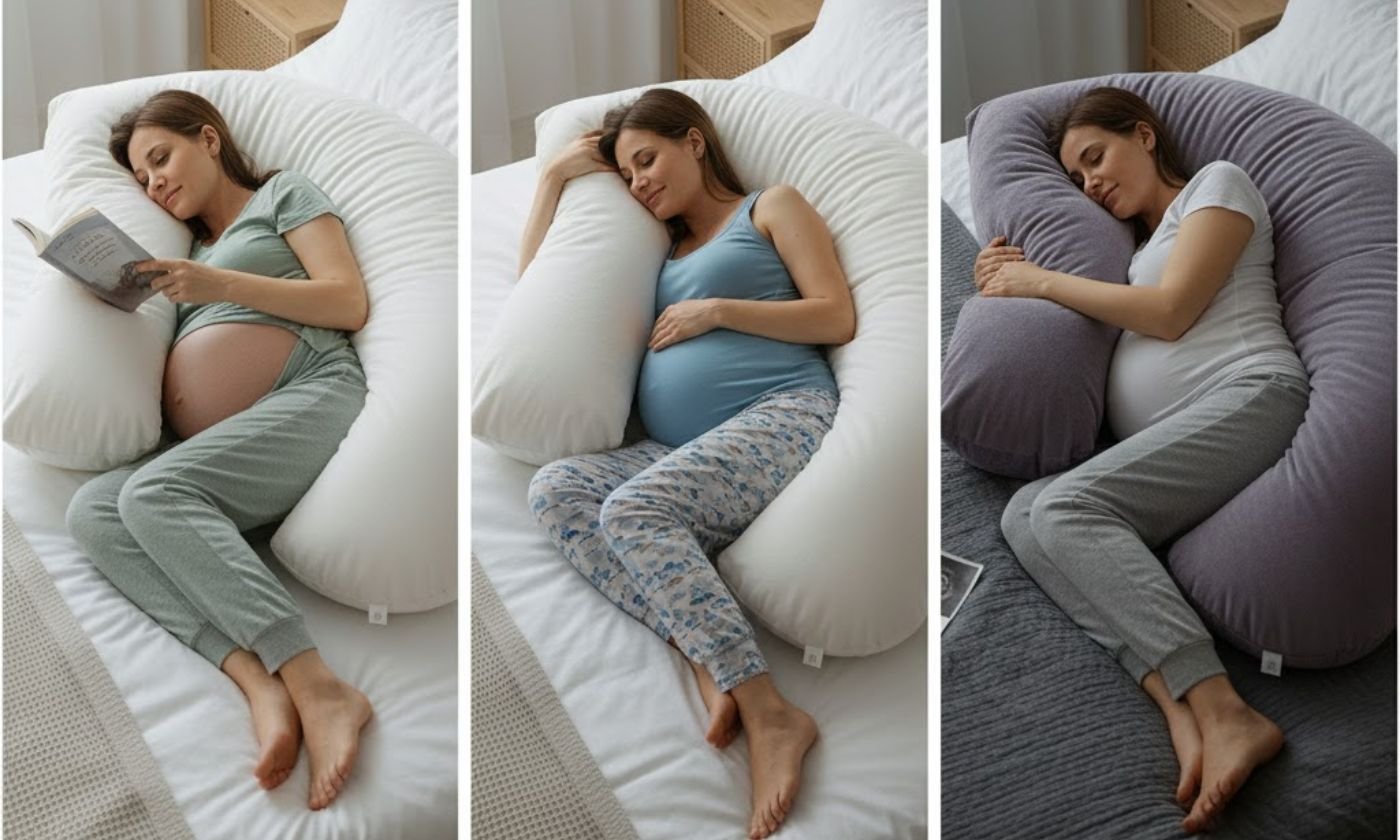
How to Wash and Care for Your Pregnancy Pillow (Complete Step-by-Step Guide for Fresh Comfort)
Pregnancy is a special journey filled with joy, change, and sometimes sleepless nights. One of the most comforting items you can have during this time is your pregnancy pillow. It provides support, reduces body pain, and helps you rest better. However, frequent use can cause it to accumulate dirt, sweat, and oils, making it less fresh over time. Knowing how to wash and care for your pregnancy pillow properly is important to maintain its hygiene, shape, and comfort. This guide will walk you through simple, effective methods to keep your pregnancy pillow clean and cozy for months.
Understanding Your Pregnancy Pillow
Pregnancy pillows come in various shapes, including U-shaped, C-shaped, wedge, and full-body designs. Each type serves a unique purpose, from supporting the belly and back to improving overall sleep posture. The cleaning process depends on the pillow’s filling and cover material. For example, polyester-filled pillows are machine washable, while memory foam pillows require gentle hand or spot cleaning. Understanding your pillow type helps you choose the right cleaning method and prevents damage during washing.
Why Regular Cleaning Is Important
Regularly cleaning your pregnancy pillow is crucial for your health and comfort. Over time, it collects sweat, oils, dust, and bacteria that can cause allergies or skin irritation. A clean pillow ensures a hygienic sleeping environment and maintains the pillow’s fluff and structure. Additionally, a freshly washed pillow smells pleasant and enhances your relaxation during sleep. Proper care not only keeps it clean but also prolongs its life, ensuring it stays supportive throughout your pregnancy.
How Often Should You Wash Your Pregnancy Pillow
The frequency of washing depends on how often you use it and whether it has a removable cover. If you use your pillow daily, wash the removable cover every one to two weeks. The inner pillow should be cleaned once every one to two months. If spills or stains occur, spot clean immediately to prevent odor or permanent discoloration. Regular maintenance keeps your pillow looking and feeling like new.
Check the Care Label Before Washing
Always start by checking the care label attached to your pregnancy pillow. The label contains important washing instructions such as recommended water temperature, washing method, and drying instructions. Some pillows are machine washable, while others require hand washing or spot cleaning. Following the manufacturer’s guidelines helps you avoid shrinking, clumping, or damaging the fabric and filling.
Pre-Wash Preparation
Before washing your pillow, remove the outer cover if it has one. Check for any tears or weak seams and repair them to prevent the filling from leaking during washing. For stained areas, apply a small amount of mild detergent or a baking soda paste to treat them. This pre-wash step ensures that the pillow and cover are thoroughly cleaned without damage.
How to Wash the Pregnancy Pillow Cover
The cover of your pregnancy pillow is usually made of cotton or a polyester blend. These materials are easy to wash. Place the cover in your washing machine and set it to a gentle or delicate cycle using cold or lukewarm water. Use a mild detergent free from harsh chemicals and fragrances. Avoid bleach or fabric softeners, as they can weaken the fabric. Once cleaned, tumble dry the cover on low heat or let it air dry for best results.
How to Wash the Pregnancy Pillow Itself
If your pillow is machine washable, use a large front-loading machine to avoid compressing or twisting the filling. Choose a delicate wash cycle with cool water and a gentle detergent. To remove soap residue, run an extra rinse cycle. When drying, use low heat and add a few clean tennis balls or dryer balls to help keep the pillow fluffy. For non-machine washable pillows, fill a bathtub or basin with lukewarm water and hand wash gently by squeezing, not wringing.
Hand Washing vs. Machine Washing
Hand washing is the safest option for delicate pillows, especially those filled with memory foam or microbeads. It allows you to control the water pressure and prevent damage. Machine washing is suitable for polyester or cotton-filled pillows that can handle agitation. Always double-check the care tag to choose the correct method for your pillow type.
Choosing the Right Detergent
Pregnancy can make your skin more sensitive, so it is important to use a gentle, hypoallergenic detergent. Look for mild detergents that are fragrance-free and safe for baby clothes, such as Dreft or Seventh Generation. Avoid using bleach or fabric softeners, as these can cause irritation and damage the material. A small amount of detergent is enough to get your pillow clean and fresh.
Spot Cleaning for Quick Refresh
If you notice a small stain or spill, spot cleaning can save time. Mix a few drops of mild detergent with warm water and dip a soft cloth into the mixture. Gently blot the stain until it lifts, then wipe the area with a damp cloth to remove residue. Allow it to air dry completely before using. This method helps maintain cleanliness without frequent washing.
Drying Your Pregnancy Pillow Properly
Drying is an important step to avoid mold or mildew growth. Air drying is the safest method, especially for foam-filled pillows. If you use a dryer, choose a low heat setting and add dryer balls to help maintain the pillow’s shape. Make sure the pillow is fully dry before use, as trapped moisture can lead to odor or bacteria buildup.
Fluffing and Shaping After Drying
Once the pillow is completely dry, give it a gentle shake to redistribute the filling evenly. You can knead or squeeze it slightly to restore its original shape. For memory foam pillows, let them air out for several hours after cleaning to remove any trapped odors or moisture. Proper fluffing ensures continued support and comfort.
Common Mistakes to Avoid
Avoid washing your pregnancy pillow in hot water, as it can cause the material to shrink. Do not use bleach, harsh detergents, or strong fabric softeners. Overwashing is another common mistake that can flatten the pillow over time. Always dry the pillow completely to prevent odor and mold.
How to Store Your Pregnancy Pillow
When not in use, store your pregnancy pillow properly to maintain its shape. Fold or roll it gently and place it in a breathable cotton bag or pillow cover. Avoid plastic bags or airtight containers that trap moisture. Store the pillow in a cool, dry place away from direct sunlight to prevent fading and odor.
Deodorizing and Freshening Tips
To keep your pillow smelling clean between washes, sprinkle baking soda over the surface and let it sit for about 30 minutes. Then vacuum the powder off completely. You can also air your pillow in sunlight for a few hours to naturally disinfect and remove unwanted smells. Lightly misting with a gentle fabric spray adds a refreshing touch.
Washing Memory Foam Pregnancy Pillows
Memory foam pillows should never be submerged in water because soaking can damage the foam’s structure. Instead, use a damp cloth and mild detergent to clean stains. Gently wipe the surface, then let the pillow air dry completely. For odor control, sprinkle baking soda and leave it on for an hour before vacuuming it off.
Caring for Different Pillow Shapes
Different shapes of pregnancy pillows require slightly different care techniques. U-shaped and C-shaped pillows are larger, so they may need to be washed in sections or in a commercial washer. Wedge pillows are small and easy to spot clean. Full-body pillows can be machine washed but should be dried thoroughly to maintain their structure.
Eco-Friendly Cleaning Tips
For an eco-friendly cleaning routine, replace harsh detergents with white vinegar or baking soda. These natural ingredients remove odors and stains effectively without leaving chemical residues. They are also safe for sensitive skin and environmentally friendly, making them ideal during pregnancy.
Removing Tough Stains
To remove tough stains like sweat or milk, mix baking soda with water to form a paste. Apply it to the stain and let it sit for 15 minutes before wiping it off with a clean, damp cloth. For greasy spots, a small drop of mild dish soap can lift oil-based marks. Rinse carefully and air dry afterward.
Maintaining Pillow Longevity
To extend the life of your pregnancy pillow, follow a simple care routine. Use a removable cover to protect it from dirt, wash regularly, and air it out weekly. Avoid sitting or putting too much weight on it to prevent flattening. Regular maintenance ensures that your pillow remains comfortable and supportive throughout pregnancy.
When to Replace Your Pregnancy Pillow
Even with the best care, your pregnancy pillow will eventually wear out. If you notice it becoming lumpy, losing firmness, or developing a lingering odor, it may be time for a replacement. Typically, a pregnancy pillow lasts about six months to a year, depending on usage and maintenance. Replacing it on time guarantees proper support and comfort.
Frequently Asked Questions
Can I put my pregnancy pillow in the dryer?
Yes, use low heat and add dryer balls to maintain fluffiness.
Can I use bleach on my pillow?
No, bleach can damage the material and cause skin irritation.
How do I make my pregnancy pillow smell fresh?
Sprinkle baking soda over it, leave for 30 minutes, and vacuum it off.
Can I wash memory foam pregnancy pillows?
No, spot clean only and avoid soaking the foam.
How do I prevent mold in my pillow?
Ensure it is completely dry before using or storing it.
Is air drying in sunlight safe?
Yes, sunlight helps disinfect and naturally deodorize the pillow.
Conclusion
Knowing how to wash and care for your pregnancy pillow is important to maintaining comfort and hygiene throughout your pregnancy. A clean pillow promotes better sleep, prevents allergies, and enhances overall relaxation. With proper washing, drying, and regular maintenance, your pillow will remain soft, supportive, and fresh. Take care of your pregnancy pillow, and it will take care of you every night.




